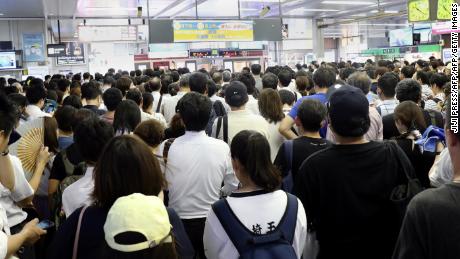
Faxai, a powerful typhoon in Japan, left more than 100 flights cancelled, thousands of travellers stranded at the airport, and nearly one million households without power. The Greater Tokyo area encountered its most violent storm in history overnight as Typhoon Faxai lashed the region, killing at least three people and leaving behind in its wake early morning transport snarls and stifling heat on Monday. The unseasonable temperatures rose as high as 37 deg Celsius in Tokyo’s Nerima ward, mere hours after Faxai – the 15th typhoon of the season – swept through the world’s largest metropolitan area, felling trees and power lines, toppling walls and scaffolding, and blowing away roofs.
According to the Japan Meteorological Agency (JMA), Typhoon Faxai, which made landfall early Monday morning in the coastal city of Chiba, brought along heavy rain and winds of up to 120 miles per hour.
The storm then moved over to Tokyo and paralysed transport. Major subway stations in Tokyo were crammed full of commuters on Monday morning, all stuck waiting for bullet trains and subway services that had shut down. As of Monday night, 670,000 homes were still without electricity, mainly in Chiba prefecture east of Tokyo. Two power transmission towers that service the prefecture had collapsed, and the Tokyo Electric Power Company has requested help from utilities companies in other regions to support its equipment restoration.
The train services gradually resumed mid-morning, but all lines are still experiencing delays.
More than 100 flights to and from airports in the Tokyo area were cancelled on Monday, including 49 Japan Airlines flights and 41 by All Nippon Airways, according to the airport website. The entire Keikyu rail line, which connects Tokyo and Yokohama to Haneda Airport, remains suspended.
As of Monday afternoon, 6,800 passengers were stranded at Narita International Airport, according to an airport spokesperson. Flights are still arriving, but with highways blocked and two railways to the city centre shut down, arriving passengers had no way to leave the airport.
Narita is one of two international airports in the Tokyo area.
Highways were shut down, departing ships were cancelled at Tokyo Port, and rail lines closed on Sunday and Monday.
Photos show flooded streets, littered with downed trees and branches. Workers on Monday tended to signposts and lamps that had blown over, and employees at the Higashi Chiba train station inspected the roof, which was twisted and torn apart.
There are also widespread blackouts — nearly a million households are without power, according to public broadcaster NHK. The islands of Shikinejima and Oshima off the country’s south coast lost power, according to the Tokyo Disaster Prevention Department.
So far there have been no deaths reported, but at least ten people have been hospitalised, NHK said on Monday.
Ahead of the typhoon, JMA issued storm surge, flood, and landslide warnings, and asked the public to avoid going outdoors.
An evacuation advisory was issued Sunday night for about 150,000 people in the Kanagawa, Shizuoka, and Tokyo prefectures, with evacuation preparation information delivered to about 2.5 million people, according to NHK. Evacuation shelters were set up across Tokyo, including the city wards of Minato, Machida, Meguro and more.
By Monday mid-morning, most of the evacuation orders across Tokyo had been cancelled, and storm warnings in the Tokyo area lifted. However, the Tokyo Disaster Prevention Management warned residents to remain alert for strong winds.